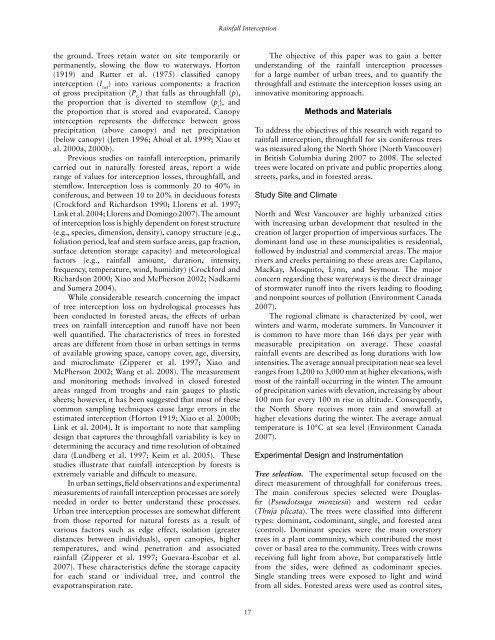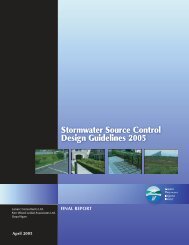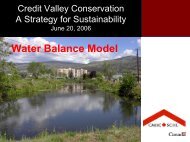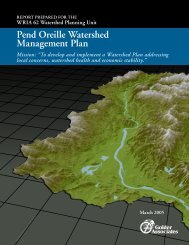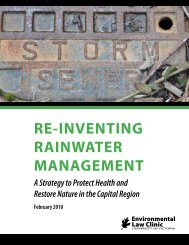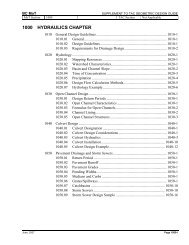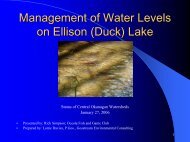A New Approach in Measuring Rainfall Interception by Urban Trees ...
A New Approach in Measuring Rainfall Interception by Urban Trees ...
A New Approach in Measuring Rainfall Interception by Urban Trees ...
You also want an ePaper? Increase the reach of your titles
YUMPU automatically turns print PDFs into web optimized ePapers that Google loves.
Ra<strong>in</strong>fall <strong>Interception</strong><br />
the ground. <strong>Trees</strong> reta<strong>in</strong> water on site temporarily or<br />
permanently, slow<strong>in</strong>g the flow to waterways. Horton<br />
(1919) and Rutter et al. (1975) classified canopy<br />
<strong>in</strong>terception (I net<br />
) <strong>in</strong>to various components: a fraction<br />
of gross precipitation (P G<br />
) that falls as throughfall (p),<br />
the proportion that is diverted to stemflow (p t<br />
), and<br />
the proportion that is stored and evaporated. Canopy<br />
<strong>in</strong>terception represents the difference between gross<br />
precipitation (above canopy) and net precipitation<br />
(below canopy) (Jetten 1996; Aboal et al. 1999; Xiao et<br />
al. 2000a, 2000b).<br />
Previous studies on ra<strong>in</strong>fall <strong>in</strong>terception, primarily<br />
carried out <strong>in</strong> naturally forested areas, report a wide<br />
range of values for <strong>in</strong>terception losses, throughfall, and<br />
stemflow. <strong>Interception</strong> loss is commonly 20 to 40% <strong>in</strong><br />
coniferous, and between 10 to 20% <strong>in</strong> deciduous forests<br />
(Crockford and Richardson 1990; Llorens et al. 1997;<br />
L<strong>in</strong>k et al. 2004; Llorens and Dom<strong>in</strong>go 2007). The amount<br />
of <strong>in</strong>terception loss is highly dependent on forest structure<br />
(e.g., species, dimension, density), canopy structure (e.g.,<br />
foliation period, leaf and stem surface areas, gap fraction,<br />
surface detention storage capacity) and meteorological<br />
factors (e.g., ra<strong>in</strong>fall amount, duration, <strong>in</strong>tensity,<br />
frequency, temperature, w<strong>in</strong>d, humidity) (Crockford and<br />
Richardson 2000; Xiao and McPherson 2002; Nadkarni<br />
and Sumera 2004).<br />
While considerable research concern<strong>in</strong>g the impact<br />
of tree <strong>in</strong>terception loss on hydrological processes has<br />
been conducted <strong>in</strong> forested areas, the effects of urban<br />
trees on ra<strong>in</strong>fall <strong>in</strong>terception and runoff have not been<br />
well quantified. The characteristics of trees <strong>in</strong> forested<br />
areas are different from those <strong>in</strong> urban sett<strong>in</strong>gs <strong>in</strong> terms<br />
of available grow<strong>in</strong>g space, canopy cover, age, diversity,<br />
and microclimate (Zipperer et al. 1997; Xiao and<br />
McPherson 2002; Wang et al. 2008). The measurement<br />
and monitor<strong>in</strong>g methods <strong>in</strong>volved <strong>in</strong> closed forested<br />
areas ranged from troughs and ra<strong>in</strong> gauges to plastic<br />
sheets; however, it has been suggested that most of these<br />
common sampl<strong>in</strong>g techniques cause large errors <strong>in</strong> the<br />
estimated <strong>in</strong>terception (Horton 1919; Xiao et al. 2000b;<br />
L<strong>in</strong>k et al. 2004). It is important to note that sampl<strong>in</strong>g<br />
design that captures the throughfall variability is key <strong>in</strong><br />
determ<strong>in</strong><strong>in</strong>g the accuracy and time resolution of obta<strong>in</strong>ed<br />
data (Lundberg et al. 1997; Keim et al. 2005). These<br />
studies illustrate that ra<strong>in</strong>fall <strong>in</strong>terception <strong>by</strong> forests is<br />
extremely variable and difficult to measure.<br />
In urban sett<strong>in</strong>gs, field observations and experimental<br />
measurements of ra<strong>in</strong>fall <strong>in</strong>terception processes are sorely<br />
needed <strong>in</strong> order to better understand these processes.<br />
<strong>Urban</strong> tree <strong>in</strong>terception processes are somewhat different<br />
from those reported for natural forests as a result of<br />
various factors such as edge effect, isolation (greater<br />
distances between <strong>in</strong>dividuals), open canopies, higher<br />
temperatures, and w<strong>in</strong>d penetration and associated<br />
ra<strong>in</strong>fall (Zipperer et al. 1997; Guevara-Escobar et al.<br />
2007). These characteristics def<strong>in</strong>e the storage capacity<br />
for each stand or <strong>in</strong>dividual tree, and control the<br />
evapotranspiration rate.<br />
The objective of this paper was to ga<strong>in</strong> a better<br />
understand<strong>in</strong>g of the ra<strong>in</strong>fall <strong>in</strong>terception processes<br />
for a large number of urban trees, and to quantify the<br />
throughfall and estimate the <strong>in</strong>terception losses us<strong>in</strong>g an<br />
<strong>in</strong>novative monitor<strong>in</strong>g approach.<br />
Methods and Materials<br />
To address the objectives of this research with regard to<br />
ra<strong>in</strong>fall <strong>in</strong>terception, throughfall for six coniferous trees<br />
was measured along the North Shore (North Vancouver)<br />
<strong>in</strong> British Columbia dur<strong>in</strong>g 2007 to 2008. The selected<br />
trees were located on private and public properties along<br />
streets, parks, and <strong>in</strong> forested areas.<br />
Study Site and Climate<br />
North and West Vancouver are highly urbanized cities<br />
with <strong>in</strong>creas<strong>in</strong>g urban development that resulted <strong>in</strong> the<br />
creation of larger proportion of impervious surfaces. The<br />
dom<strong>in</strong>ant land use <strong>in</strong> these municipalities is residential,<br />
followed <strong>by</strong> <strong>in</strong>dustrial and commercial areas. The major<br />
rivers and creeks perta<strong>in</strong><strong>in</strong>g to these areas are: Capilano,<br />
MacKay, Mosquito, Lynn, and Seymour. The major<br />
concern regard<strong>in</strong>g these waterways is the direct dra<strong>in</strong>age<br />
of stormwater runoff <strong>in</strong>to the rivers lead<strong>in</strong>g to flood<strong>in</strong>g<br />
and nonpo<strong>in</strong>t sources of pollution (Environment Canada<br />
2007).<br />
The regional climate is characterized <strong>by</strong> cool, wet<br />
w<strong>in</strong>ters and warm, moderate summers. In Vancouver it<br />
is common to have more than 166 days per year with<br />
measurable precipitation on average. These coastal<br />
ra<strong>in</strong>fall events are described as long durations with low<br />
<strong>in</strong>tensities. The average annual precipitation near sea level<br />
ranges from 1,200 to 3,000 mm at higher elevations, with<br />
most of the ra<strong>in</strong>fall occurr<strong>in</strong>g <strong>in</strong> the w<strong>in</strong>ter. The amount<br />
of precipitation varies with elevation, <strong>in</strong>creas<strong>in</strong>g <strong>by</strong> about<br />
100 mm for every 100 m rise <strong>in</strong> altitude. Consequently,<br />
the North Shore receives more ra<strong>in</strong> and snowfall at<br />
higher elevations dur<strong>in</strong>g the w<strong>in</strong>ter. The average annual<br />
temperature is 10°C at sea level (Environment Canada<br />
2007).<br />
Experimental Design and Instrumentation<br />
Tree selection. The experimental setup focused on the<br />
direct measurement of throughfall for coniferous trees.<br />
The ma<strong>in</strong> coniferous species selected were Douglasfir<br />
(Pseudotsuga menziesii) and western red cedar<br />
(Thuja plicata). The trees were classified <strong>in</strong>to different<br />
types: dom<strong>in</strong>ant, codom<strong>in</strong>ant, s<strong>in</strong>gle, and forested area<br />
(control). Dom<strong>in</strong>ant species were the ma<strong>in</strong> overstory<br />
trees <strong>in</strong> a plant community, which contributed the most<br />
cover or basal area to the community. <strong>Trees</strong> with crowns<br />
receiv<strong>in</strong>g full light from above, but comparatively little<br />
from the sides, were def<strong>in</strong>ed as codom<strong>in</strong>ant species.<br />
S<strong>in</strong>gle stand<strong>in</strong>g trees were exposed to light and w<strong>in</strong>d<br />
from all sides. Forested areas were used as control sites,<br />
17


